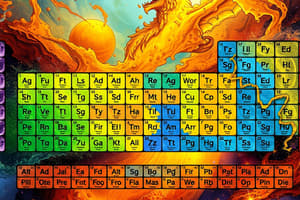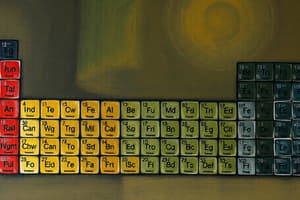Podcast
Questions and Answers
The idea of arranging the elements in the periodic table according to their chemical and physical properties is attributed to?
The idea of arranging the elements in the periodic table according to their chemical and physical properties is attributed to?
Mendeleev
Mendeleev noticed that properties of elements usually repeated at regular intervals when the elements were arranged in order of increasing?
Mendeleev noticed that properties of elements usually repeated at regular intervals when the elements were arranged in order of increasing?
atomic mass
Mendeleev did not always list elements in his periodic table in order of increasing atomic mass because he grouped together elements with similar?
Mendeleev did not always list elements in his periodic table in order of increasing atomic mass because he grouped together elements with similar?
properties
Mendeleev predicted that the spaces in his periodic table represented?
Mendeleev predicted that the spaces in his periodic table represented?
The person whose work led to a periodic table based on increasing atomic number was?
The person whose work led to a periodic table based on increasing atomic number was?
The periodic table permits the properties of an element to be predicted before the element is discovered?
The periodic table permits the properties of an element to be predicted before the element is discovered?
What are the radioactive elements with atomic numbers from 90 to 103 called?
What are the radioactive elements with atomic numbers from 90 to 103 called?
Argon, krypton, and xenon are?
Argon, krypton, and xenon are?
The periodic law allows some properties of an element to be predicted based on its?
The periodic law allows some properties of an element to be predicted based on its?
Elements in a group or column in the periodic table can be expected to have similar?
Elements in a group or column in the periodic table can be expected to have similar?
How much greater is the atomic number of the fourth element in groups 1, 2, and 18 than the preceding element?
How much greater is the atomic number of the fourth element in groups 1, 2, and 18 than the preceding element?
In the pattern 8, 8, 18, __, 32, what number completes the pattern for elements in groups 1, 2, and 18?
In the pattern 8, 8, 18, __, 32, what number completes the pattern for elements in groups 1, 2, and 18?
A horizontal row of blocks in the periodic table is called a?
A horizontal row of blocks in the periodic table is called a?
Identify the sublevels in a period that contains 32 elements?
Identify the sublevels in a period that contains 32 elements?
How many elements are in a period in which only the s and p sublevels are filled?
How many elements are in a period in which only the s and p sublevels are filled?
In what period is cesium, with atomic number 55?
In what period is cesium, with atomic number 55?
In period 3 there are 8 elements. What sublevel(s) is (are) being filled?
In period 3 there are 8 elements. What sublevel(s) is (are) being filled?
Period 4 contains 18 elements. How many of these elements have electrons in the d sublevel?
Period 4 contains 18 elements. How many of these elements have electrons in the d sublevel?
In what period is calcium, atomic number 20?
In what period is calcium, atomic number 20?
The s sublevel of the highest occupied energy level varies in the number of electrons it contains?
The s sublevel of the highest occupied energy level varies in the number of electrons it contains?
Neutral atoms with an s^2p^6 electron configuration in the highest energy level belong to which block of the periodic table?
Neutral atoms with an s^2p^6 electron configuration in the highest energy level belong to which block of the periodic table?
The group of 14 f block elements in the sixth period is called?
The group of 14 f block elements in the sixth period is called?
Within the p-block elements, the elements at the top of the table, compared with those at the bottom, are?
Within the p-block elements, the elements at the top of the table, compared with those at the bottom, are?
The electron configurations of the noble gases from neon to radon in the periodic table make these elements part of the?
The electron configurations of the noble gases from neon to radon in the periodic table make these elements part of the?
Hydrogen is placed separately from other elements in the periodic table because it?
Hydrogen is placed separately from other elements in the periodic table because it?
For groups 13 through 18, the total number of electrons in the highest occupied level equals the group number minus?
For groups 13 through 18, the total number of electrons in the highest occupied level equals the group number minus?
The electron configuration of an element is [Kr] 4d^6 5s^1. To what group does this element belong?
The electron configuration of an element is [Kr] 4d^6 5s^1. To what group does this element belong?
Which block in the periodic table contains the alkali metals?
Which block in the periodic table contains the alkali metals?
The most reactive group of nonmetals is the?
The most reactive group of nonmetals is the?
The group of soft, silvery, reactive metals, all of which have one electron in an s orbital, is known as the?
The group of soft, silvery, reactive metals, all of which have one electron in an s orbital, is known as the?
The first member of the noble gas family, whose highest energy level consists of an octet of electrons, is?
The first member of the noble gas family, whose highest energy level consists of an octet of electrons, is?
The most characteristic property of the noble gases is that they?
The most characteristic property of the noble gases is that they?
One-half the distance between the nuclei of identical atoms bonded together is called the?
One-half the distance between the nuclei of identical atoms bonded together is called the?
What is removed when the ionization energy is supplied to an atom of an element?
What is removed when the ionization energy is supplied to an atom of an element?
The element that has the greatest electronegativity is?
The element that has the greatest electronegativity is?
A positive ion is known as a(n)?
A positive ion is known as a(n)?
In a row in the periodic table, as the atomic number increases, the atomic radius generally?
In a row in the periodic table, as the atomic number increases, the atomic radius generally?
Within a group of elements, as the atomic number increases, the atomic radius?
Within a group of elements, as the atomic number increases, the atomic radius?
Across a period in the periodic table, atomic radii?
Across a period in the periodic table, atomic radii?
Which is the best reason that the atomic radius generally increases with atomic number in each group of elements?
Which is the best reason that the atomic radius generally increases with atomic number in each group of elements?
The ionization energies required to remove successive electrons from a mole of calcium atoms are 590 kJ/mol, 1145 kJ/mol, and 6474 kJ/mol. The most common ion of calcium is probably?
The ionization energies required to remove successive electrons from a mole of calcium atoms are 590 kJ/mol, 1145 kJ/mol, and 6474 kJ/mol. The most common ion of calcium is probably?
As you move left to right in Period 4 from gallium through bromine, atomic radii?
As you move left to right in Period 4 from gallium through bromine, atomic radii?
The force of attraction by Group 1 metals for their valence electrons is?
The force of attraction by Group 1 metals for their valence electrons is?
The electrons available to be lost, gained, or shared when atoms form compounds are called?
The electrons available to be lost, gained, or shared when atoms form compounds are called?
The number of valence electrons in Group 1 elements is?
The number of valence electrons in Group 1 elements is?
In Group 2 elements, the valence electrons are in sublevel?
In Group 2 elements, the valence electrons are in sublevel?
The number of valence electrons in Group 17 elements is?
The number of valence electrons in Group 17 elements is?
In groups 13 through 18, valence electrons may be in sublevels?
In groups 13 through 18, valence electrons may be in sublevels?
Across a period, ionization energies of d-block elements generally?
Across a period, ionization energies of d-block elements generally?
The first electrons to be removed when d-block elements form ions are the?
The first electrons to be removed when d-block elements form ions are the?
State the Periodic Law.
State the Periodic Law.
Flashcards are hidden until you start studying
Study Notes
Periodic Table Development
- Mendeleev is recognized for arranging elements in the periodic table based on chemical and physical properties.
- He observed that element properties repeat at regular intervals when ordered by atomic mass.
- Mendeleev prioritized grouping elements by similar properties rather than strictly by atomic mass.
- He predicted that gaps in his table indicated undiscovered elements.
Modern Periodic Table
- Moseley's work led to the periodic table organization based on increasing atomic number instead of atomic mass.
- The periodic law predicts element properties based on their location within the periodic table.
- Elements in the same group or column exhibit similar chemical properties.
Element Groups and Blocks
- Radioactive elements with atomic numbers 90 to 103 are termed actinides.
- Noble gases include argon, krypton, and xenon, noted for their lack of reactivity.
- The p block comprises noble gases, such as neon to radon, and elements with a s^2p^6 configuration.
Electron Configuration
- Unfilled sublevels determine the number of elements in a period; periods with 32 elements include s, p, d, and f sublevels.
- Elements in periods where only the s and p sublevels are filled contain 8 elements.
- The electron configuration of an element (example: cesium, atomic number 55, is [Xe] 6s^1) indicates its period.
Atomic and Ionic Properties
- Atomic radius is defined as half the distance between the nuclei of bonded atoms.
- As atomic number increases in a period, atomic radius generally decreases.
- In a group, atomic radius increases with increasing atomic number due to additional occupied energy levels.
Ionization Energy and Electronegativity
- Ionization energy is the energy required to remove an electron from an atom.
- Calcium's common ion, due to its ionization energies, is likely Ca^2+.
- Fluorine exhibits the highest electronegativity, making it very reactive in forming compounds.
Valence Electrons
- Valence electrons are electrons that can be gained, lost, or shared when forming chemical bonds.
- Group 1 elements have 1 valence electron, while Group 17 elements have 7.
- In groups 13 to 18, valence electrons reside in s and p sublevels.
General Trends in the Periodic Table
- Across a period, atomic radii decrease while ionization energies typically increase.
- D-block elements see their first electrons removed from the s sublevel when forming ions.
- The force of attraction for valence electrons diminishes in Group 1 metals, leading to high reactivity.
Summary of Periodic Law
- The Periodic Law asserts that physical and chemical properties of elements are periodic functions of their atomic numbers.
Studying That Suits You
Use AI to generate personalized quizzes and flashcards to suit your learning preferences.




